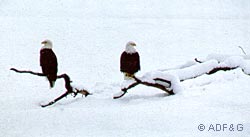Chilkat River —
Critical Habitat Area
Fish and Wildlife
Birds
 In the fall and winter, bald eagles gather at the confluence of the clear Tsirku and glacial Chilkat rivers to feed on
late run fall chum salmon. Portions of the river
remain ice-free into the winter due to unusual upwellings of warm water. This phenomenon allows salmon to return and
spawn much later than in surrounding streams in the region, providing a unique and critical food source for bald eagles
from throughout the region and as far away as Washington state. Bald eagle numbers usually peak in early to mid-November
when up to 4,000 may be present. The birds remain in the area to feed on salmon carcasses through February. Dabbling
ducks including mallards, teal, wigeon, and pintails and some diving ducks, especially mergansers, frequent the Chilkat
River. Gulls can be found in greatest numbers
feeding on spawned-out salmon. Willow ptarmigan,
ravens, crows, and magpies are resident to the area.
Seasonally, a wide variety of passerines and raptors can be sighted as well.
In the fall and winter, bald eagles gather at the confluence of the clear Tsirku and glacial Chilkat rivers to feed on
late run fall chum salmon. Portions of the river
remain ice-free into the winter due to unusual upwellings of warm water. This phenomenon allows salmon to return and
spawn much later than in surrounding streams in the region, providing a unique and critical food source for bald eagles
from throughout the region and as far away as Washington state. Bald eagle numbers usually peak in early to mid-November
when up to 4,000 may be present. The birds remain in the area to feed on salmon carcasses through February. Dabbling
ducks including mallards, teal, wigeon, and pintails and some diving ducks, especially mergansers, frequent the Chilkat
River. Gulls can be found in greatest numbers
feeding on spawned-out salmon. Willow ptarmigan,
ravens, crows, and magpies are resident to the area.
Seasonally, a wide variety of passerines and raptors can be sighted as well.
Mammals
Brown and black bears are seasonally attracted to the Chilkat River to feed on spawning salmon. Moose move through the area in November on their way to coastal wintering areas and again in the spring as they return to higher elevations. Sitka black-tailed deer occur in small numbers. Coyote and red fox can be found feeding opportunistically on salmon carcasses, other carrion, and small mammals. Lynx, wolverine, and wolves are known to range through the area. Mink, weasel, and land otter are found along the river, feeding on fish, birds, birds' eggs, and small carrion. Numerous small mammals are known to occur in the area including squirrels, voles, shrews, bats, mice, and snowshoe hares.
Fish
Five species of Pacific salmon occur in the Chilkat River system: pink, chum, coho, sockeye, and king; as well as Dolly Varden char, steelhead, cutthroat trout, and whitefish. In mid-November, after most of the Chilkat River has iced up, the three-mile stretch known as the Bald Eagle Council Grounds is still open, fed by warm upwelling water. In this stretch of river, the chum salmon has evolved a late run population which returns to the gravel bed to spawn in late fall. This unique resource attracts the bald eagles to the area long after other food sources are no longer available.
